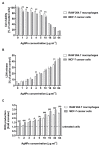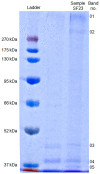Green Synthesized Silver Nanoparticles: Antibacterial and Anticancer Activities, Biocompatibility, and Analyses of Surface-Attached Proteins
- PMID: 33967977
- PMCID: PMC8100210
- DOI: 10.3389/fmicb.2021.632505
Green Synthesized Silver Nanoparticles: Antibacterial and Anticancer Activities, Biocompatibility, and Analyses of Surface-Attached Proteins
Abstract
The increasing number of multi-drug-resistant bacteria and cancer cases, that are a real threat to humankind, forces research world to develop new weapons to deal with it. Biogenic silver nanoparticles (AgNPs) are considered as a solution to this problem. Biosynthesis of AgNPs is regarded as a green, eco-friendly, low-priced process that provides small and biocompatible nanostructures with antimicrobial and anticancer activities and potential application in medicine. The biocompatibility of these nanoparticles is related to the coating with biomolecules of natural origin. The synthesis of AgNPs from actinobacterial strain was confirmed using UV-Vis spectroscopy while their morphology, crystalline structure, stability, and coating were characterized using, transmission electron microscopy (TEM), X-ray diffraction (XRD), Zeta potential and Fourier transform infrared spectroscopy (FTIR). Antibacterial activity of biogenic AgNPs was evaluated by determination of minimum inhibitory and minimum biocidal concentrations (MIC and MBC) against Escherichia coli, Klebsiella pneumoniae, Pseudomonas aeruginosa, and Staphylococcus aureus. The potential mechanism of antibacterial action of AgNPs was determined by measurement of ATP level. Since the use of AgNPs in biomedical applications depend on their safety, the in vitro cytotoxicity of biosynthesized AgNPs on MCF-7 human breast cancer cell line and murine macrophage cell line RAW 264.7 using MTT [3-(4,5-dimethylthiazol-2-yl)-2,5-diphenyltetrazolium bromide] assay, cell lactate dehydrogenase (LDH) release and measurement of reactive oxygen species (ROS) level were assessed. The nanoparticle protein capping agent that can be involved in reduction of silver ions to AgNPs and their stabilization was identified using LC-MS/MS. Nanoparticles were spherical in shape, small in size (mean 13.2 nm), showed crystalline nature, good stability (-18.7 mV) and presence of capping agents. They exhibited antibacterial activity (MIC of 8-128 μg ml-1, MBC of 64-256 μg ml-1) and significantly decreased ATP levels in bacterial cells after treatment with different concentrations of AgNPs. The in vitro analysis showed that the AgNPs demonstrated dose-dependent cytotoxicity against RAW 264.7 macrophages and MCF-7 breast cancer cells but higher against the latter than the former. Cell viability decrease was found to be 42.2-14.2 and 38.0-15.5% while LDH leakage 14.6-42.7% and 19.0-45.0%, respectively. IC50 values calculated for MTT assay was found to be 16.3 and 12.0 μg ml-1 and for LDH assay 102.3 and 76.2 μg ml-1, respectively. Moreover, MCF-7 cells released a greater amount of ROS than RAW 264.7 macrophages during stimulation with all tested concentrations of AgNPs (1.47-3.13 and 1.02-2.58 fold increase, respectively). The SDS-PAGE (sodium dodecyl sulfate-polyacrylamide gel electrophoresis) analysis revealed the presence of five protein bands at a molecular weight between 31.7 and 280.9 kDa. These proteins showed the highest homology to hypothetical proteins and porins from E. coli, Delftia sp. and Pseudomonas rhodesiae. Based on obtained results it can be concluded that biogenic AgNPs were capped with proteins and demonstrated potential as antimicrobial and anticancer agent.
Keywords: MCF-7; RAW 264.7; antibacterial agent; anticancer agent; biogenic AgNPs; capping agents; cytotoxicity; protein molecules.
Copyright © 2021 Wypij, Jędrzejewski, Trzcińska-Wencel, Ostrowski, Rai and Golińska.
Conflict of interest statement
The authors declare that the research was conducted in the absence of any commercial or financial relationships that could be construed as a potential conflict of interest.
Figures








Similar articles
-
Biogenic Silver Nanoparticles: Assessment of Their Cytotoxicity, Genotoxicity and Study of Capping Proteins.Molecules. 2020 Jul 2;25(13):3022. doi: 10.3390/molecules25133022. Molecules. 2020. PMID: 32630696 Free PMC article.
-
Biogenic Synthesis of Silver Nanoparticles using Lasiosiphon eriocephalus (Decne): In vitro Assessment of their Antioxidant, Antimicrobial and Cytotoxic Activities.Pharm Nanotechnol. 2023;11(2):180-193. doi: 10.2174/2211738511666221207153116. Pharm Nanotechnol. 2023. PMID: 36503464
-
Anticancer and antimicrobial activity of biosynthesized Red Sea marine algal silver nanoparticles.Sci Rep. 2022 Feb 14;12(1):2421. doi: 10.1038/s41598-022-06412-3. Sci Rep. 2022. PMID: 35165346 Free PMC article.
-
Green Synthesis of Silver Nanoparticles Loaded Hydrogel for Wound Healing; Systematic Review.Gels. 2023 Jun 29;9(7):530. doi: 10.3390/gels9070530. Gels. 2023. PMID: 37504410 Free PMC article. Review.
-
Green Synthesis, Characterization, and Potential Antibacterial and Anticancer Applications of Gold Nanoparticles: Current Status and Future Prospects.Biomedicines. 2025 May 13;13(5):1184. doi: 10.3390/biomedicines13051184. Biomedicines. 2025. PMID: 40427012 Free PMC article. Review.
Cited by
-
Silver Nanoparticles in Therapeutics and Beyond: A Review of Mechanism Insights and Applications.Nanomaterials (Basel). 2024 Oct 10;14(20):1618. doi: 10.3390/nano14201618. Nanomaterials (Basel). 2024. PMID: 39452955 Free PMC article. Review.
-
Ocimum basilicum-Mediated Synthesis of Silver Nanoparticles Induces Innate Immune Responses against Cucumber Mosaic Virus in Squash.Plants (Basel). 2022 Oct 13;11(20):2707. doi: 10.3390/plants11202707. Plants (Basel). 2022. PMID: 36297731 Free PMC article.
-
Biogenic Silver Nanoparticles: What We Know and What Do We Need to Know?Nanomaterials (Basel). 2021 Oct 29;11(11):2901. doi: 10.3390/nano11112901. Nanomaterials (Basel). 2021. PMID: 34835665 Free PMC article. Review.
-
Fungal-Mediated Silver Nanoparticle and Biochar Synergy against Colorectal Cancer Cells and Pathogenic Bacteria.Antibiotics (Basel). 2023 Mar 16;12(3):597. doi: 10.3390/antibiotics12030597. Antibiotics (Basel). 2023. PMID: 36978464 Free PMC article.
-
Catharanthus roseus-assisted bio-fabricated zinc oxide nanoparticles for promising antibacterial potential against Klebsiella pneumoniae.Bioprocess Biosyst Eng. 2024 Aug;47(8):1259-1269. doi: 10.1007/s00449-024-03001-8. Epub 2024 Mar 25. Bioprocess Biosyst Eng. 2024. PMID: 38526617
References
-
- Abbaszadegan A., Ghahramani Y., Gholami A., Hemmateenejad B., Dorostkar S., Nabavizadeh M. (2015). The effect of charge at the surface of silver nanoparticles on antimicrobial activity against gram-positive and gram-negative bacteria: a preliminary study. J. Nanomater. 2015:8. 10.1155/2015/720654 - DOI
-
- Akhtar M., Panwar J., Yun Y. (2013). Biogenic synthesis of metallic nanoparticles by plant extracts. ACS Sustain. Chem. Eng. 1, 591–602. 10.1021/sc300118u - DOI
LinkOut - more resources
Full Text Sources
Other Literature Sources
Molecular Biology Databases

